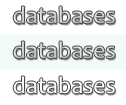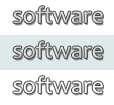Custom Software Design and Programming
In addition to custom database applications, DataGnostics will develop custom non-database software to solve data problems you may encounter:
moving data
from one application into another: in-house, between PC applications or cross-platform between mainframe and PC systems.receiving data
from outside sources in a form that isn't useful to you, which you need to convert, rationalize, or standardize before you can work with it.converting your data
into a form specified by an outside organization, either corporate or governmental.
Here are a few examples of DataGnostics custom software projects. We also do spot consulting and training with a variety of clients, either as one-time arrangements or as ongoing relationships.
problem:
The NJ State Superior Court needed a single pool of eligible jurors, by county. What they had were separate files of motor vehicle records, tax records, and voter rolls for each of 21 counties with idiosyncratic file formats and content.
solution:
Rexx programs to merge and reconcile files, PL/I programs to identify huge numbers of duplicate and inappropriate names and addresses, and create a single file per county in the specific format needed to drive the jury selection process.
problem:
The client was a major hospital with $3 million/year in telecommunications charges from several carriers. The bills and call traffic data submitted by the carriers (on magnetic tapes for IBM mainframe processing) did not directly permit the hospital to allocate and chargeback calls and equipment to departments and billable clinical practices.
solution:
A PC system for inventory and management of installed telecommunications equipment, and to allocate costs of service and other line charges. A mainframe system to recombine and reconcile data from different telecommunications carriers and incorporate the output of the PC system so that billable calls and equipment costs can be charged back to the appropriate department. The system prints out 8000 pages of bills at the end of every month.
problem:
The client's mainframe generated data on 500,000 financial transactions per month, which needed to be summarized for the general ledger system.
solution:
A Microsoft Access database to maintain the rules for assigning transactions to general-ledger accounts and line items, and to apply these rules each month to summarize the data, produce accounting reports, and furnish entries for the client's general ledger system.








